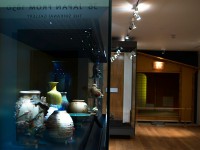Room 36 | Japan from 1850 gallery
Explore the major technical and creative developments in arts and crafts of Japan after 1850 and visit the Ashmolean's tea house.

Galleries : 6 objects
Show search help- Reference URL
Actions
Incense burner, or kōro, with an entrance gate amid trees
-
Details
- Associated place
-
Asia › Japan › Honshū › Kyōto prefecture › Kyoto (place of creation)
- Date
- c. 1905
- Artist/maker
-
Namikawa Yasuyuki (1845 - 1927)
- Material and technique
- metal, inlaid with gold wire cloisonné enamel; silver mounts
- Dimensions
-
with lid 8.9 cm (height)
without lid 7.6 cm (height)
7 cm (diameter)
- Material index
-
processed material › metal › gold,
- Technique index
- Object type index
- No. of items
- 2
- Credit line
- Purchased with the assistance of the Story Fund, 2000.
- Accession no.
- EA2000.180
-
Further reading
Impey, Oliver, and Joyce Seaman, Japanese Decorative Arts of the Meiji Period 1868-1912, Ashmolean Handbooks (Oxford: Ashmolean Museum, 2005), no. 37 on p. 78, pp. 8, 22, & 74, illus. pp. 78-79
Glossary (3)
cloisonné, koro, kōro
-
cloisonné
Decorative technique in which wires are attached to a metal body and coloured enamels are applied between the wires.
-
koro
A Japanese incense burner.
-
kōro
A Japanese incense burner.
Location
Objects are sometimes moved to a different location. Our object location data is usually updated on a monthly basis. Contact the Jameel Study Centre if you are planning to visit the museum to see a particular object on display, or would like to arrange an appointment to see an object in our reserve collections.
Collection trails
Galleries
Publications online
-

Japanese Decorative Arts of the Meiji Period
Baluster shaped incense burner with a lid pierced as a chrysanthemum. A building appears amid trees in a landscape in gold wire on a green ground. Signed; Kyōto Namikawa on a silver tablet.
Turning to landscape as a subject, in the early 1900s, Yasuyuki was almost obliged to use shaded backgrounds, which he had usually avoided before. In this gold-wired incense burner, there is another new technique, the use of triangular cross-sections of wire set in the picture end on, to act as leaves or flower-petals.
Notice
Objects may have since been removed or replaced from a gallery. Click into an individual object record to confirm whether or not an object is currently on display. Our object location data is usually updated on a monthly basis, so contact the Jameel Study Centre if you are planning to visit the museum to see a particular Eastern Art object.
© 2013 University of Oxford - Ashmolean Museum









